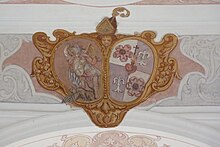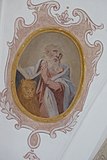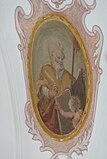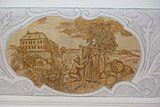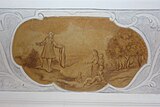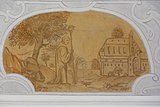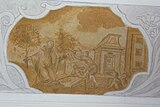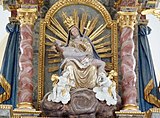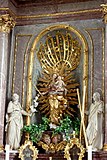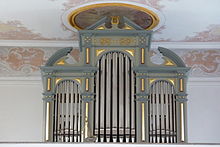St. Leonhard (Baiershofen)
The Catholic parish church of St. Leonhard in Baiershofen , a district of Altenmünster in the Augsburg district in the Bavarian administrative district of Swabia , was built in the first half of the 18th century on the site of a previous church from the 15th century. The ceiling frescoes and murals were done by Dominikus Zimmermann (1685–1766).
history
The place Baiershofen was founded around 1350 as a clearing settlement of the Fultenbach monastery . At that time there was already a settlement south of today's town and also belonging to the Fultenbach monastery. This settlement had a parish church dedicated to the Apostle Andrew , which was demolished in 1789. Around 1450 a new church was built in the village of Anger von Baiershofen, which replaced the old St. Andrew's church as the parish church. The patronage of St. Leonhard von Limoges was chosen , who is venerated in Bavaria as a helper in need and patron saint of cattle , especially horses. All pastors have been known by name since the church was built. They were monks from the Fultenbach monastery, who held the land rulership of the place and the church patronage and also exercised high jurisdiction . A new choir was built in 1701, followed by a new nave in 1730 . The tower octagon was probably put on during this time .
architecture
In the northern corner of the choir rises the bell tower crowned with an onion dome, the square base of which goes back to the previous church from the 15th century. The lower floors are divided by glare fields with pointed arch friezes. The bell storey is pierced by segment-arched sound arcades .
The nave has a single nave and is covered with a flat ceiling over a valley . The slightly retracted choir has a barrel vault with stitch caps and closes with a semicircular apse .
Piece
The stucco decor was created around 1710/20. On the left of the choir arch is the coat of arms of the Fultenbach monastery in a stucco cartouche , which depicts the Archangel Michael fighting with Lucifer . The right side shows the coat of arms of Abbot Michael Schiele, who headed the Fultenbach monastery from 1723 to 1765. This coat of arms is divided into four fields, on which roses and lilies are depicted and in the middle of which a flaming heart is emblazoned with a cross.
Ceiling pictures
The choir fresco depicts the Eye of God , the Holy Trinity and the Heart of Mary, pierced by a sword and surrounded by a wreath of flowers, from which a chalice with a cross emerges. The four evangelists are depicted on the side medallions .
The ceiling frescos of the nave are dedicated to the patron saint of the church. The grisaille depict scenes from the legend of St. Leonhard: Leonhard supports a Frankish queen in a difficult birth, he founds the monastery of St-Léonard-de-Noblat near Limoges , Leonhard converts unbelievers who then smash an idol, a prisoner in Chains begs the saint for help, Leonhard helps a mother and her children, Leonhard lets a spring spring up.
Furnishing
- The pulpit dates from the late 17th century. The pulpit is decorated with angel heads with statuettes on them, including Moses with the tablets of the law. On the sound cover sit angel putti , which frame Saint Leonhard, who is dressed in a monk's robe and holds his abbot's staff and chains in his hands.
- The high altar from the early 18th century has a sculpture of St. Leonhard, at whose feet an angel, shepherd and animals are depicted. The sculptures are dated around 1720/30 and attributed to Stephan Luidl. The figures on the side also date from the early 18th century. On the left they depict St. Benedict of Nursia with a book, the Benedictine Rule , in hand and St. Magnus von Füssen with his attribute , the dragon at his feet. The Pietà in the altarpiece is dated to the second quarter of the 18th century .
- The stucco marble side altars date from around 1790. The side figures of the left altar depict St. Joseph and the Apostle Andreas, those of the right altar depict St. Benedict and his sister, the Holy Scholastica . In the middle niche of the left side altar there is a mother of God in a halo from the early 18th century, perhaps a work by the sculptor Anselm Libigo. The figure of St. John Nepomuk in the middle of the right altar is dated around 1740/50.
- The paintings of the Stations of the Cross were done by Dominikus Zimmermann. The picture of the first station bears the signature: "Dominici: Zimmemann: pinx: Wess". The scenes are each provided with a portrait of an apostle.
organ
The organ was installed in the 19th century by the organ building company Franz Xaver Frosch from Munich and restored in 2000 by the company Georg Weishaupt in Westendorf .
literature
- Georg Dehio: Handbook of German Art Monuments - Bavaria III - Swabia (arr.: Bruno Bushart, Georg Paula) . Revised edition, Deutscher Kunstverlag, Munich 1989, ISBN 3-422-03008-5 , p. 164.
Web links
- History of Baiershofen Text of the Altenmünster community
- Parish of St. Leonhard
- Baiershofen (PDF file; 18 kB) Bavarian State Office for Monument Preservation
Individual evidence
- ^ Parish St. Leonhard - Baiershofen Diocese of Augsburg
- ^ Coat of arms of the Fultenbach monastery
- ^ Leonhard von Noblat (from Limoges) Ecumenical Lexicon of Saints
Coordinates: 48 ° 27 '29.8 " N , 10 ° 33' 8.1" E


